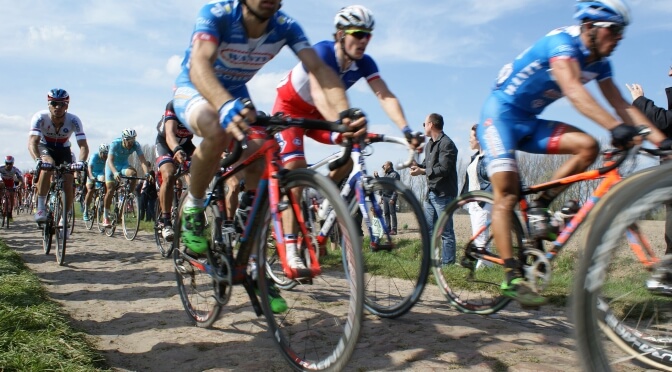The following post comes from Starley Pro Cycling rider Gaby Leveridge, who also blogs at Go Faster Gaby. Here she reveals everything you need to know before tackling the Paris-Roubaix route.
While you shake and rattle your way around the course, you can rest assured that this is a brilliantly organised sportive designed to host thousands of classics enthusiasts. There are plenty of feed stations and mechanical help along the route, so if your bike struggles a bit with the terrain or you need more fuel to get you through, there will be a helping hand available.
Make sure that you check the route map and know where and how often you will come across these services. I would always recommend carrying some emergency snacks in a jerseys pocket and make sure you have a couple of inner tubes, a reliable hand pump and multi-tool just in case.
Preparing your bicycle for riding on cobbles

Get a saddle that supports your pelvis so you can pedal hard over the cobbles without rocking around or slipping. In the past I have used the Fabric Scoops saddles in shallow and radius shapes and found them perfect for this.
Double wrapping your handlebars is a good idea to help absorb some of the vibration from the cobbles, or at least double wrap on the top. Hold your bars lightly and concentrate on absorbing most of the juddering through your legs.
Make sure you check that all the bolts on your bike are tight so nothing rattles off – you don’t want to lose your water bottle halfway round or feel your seatpost slipping down.
Try to keep your chain tight and shift smoothly as bouncing and shifting can cause a very jumpy chain.
If you can, run larger tyres than normal – 27-30 cm are ideal. You can run these at a lower pressure too; around 70psi works well depending on your weight. Always run them less than when just road riding. You’ll appreciate the extra comfort and grip.
What to wear while cycling

Take an extra layer with you. While there’s always something satisfying about battling your way through the elements, a gilet or thin jacket is a good comfort blanket in case of bad weather.
Don’t forget about the little things – hats, gloves, shoe covers and buffs can make a huge difference and fit easily in a jersey pocket.
How to cycle on cobbles

There are a few things to bear in mind when riding on cobbles. Most people find that spinning in lower gear is better than trying to mash a higher gear.
As you approach a cobbled section, try to get into the gear you think you are going to want. It’s good to minimise shifting whilst on the cobbles. Try to spin your legs in smooth circles, keeping a constancy in your cadence – this is something you can practice on your rides at home.
The sides of the cobbled sections are usually smoother than the middle, so plan your route carefully. Sometimes the cobbles can be missing in the middle, and on Paris-Roubaix the holes are notoriously large.
Pick your line and keep going. If you stop it can be hard to get going again, especially if it is wet and the cobbles are slippery.
Enjoy the ride!

Most of all though, enjoy it. If you’re riding with a group of friends, make sure you take the time to look at the scenery and absorb the atmosphere and the history of the race. You can take it in turns to ride on the front and shelter each other from the wind.
But don’t worry if you’re heading out alone. You’ll be accompanied by fleets of other cycle fans to chat to and experience the day with. Remember, the classics are tough, but that’s what has earned them their epic gritty status as the kick-off to spring cycling.
For more tips and inspiration, be sure to read Gaby’s first guest post, “Travel by ferry for a weekend of cobbled classic history”, or click here to find out everything you need to know about travelling with your bicycle on a P&O Ferry.
Featured image by Olivier Duquesne.



